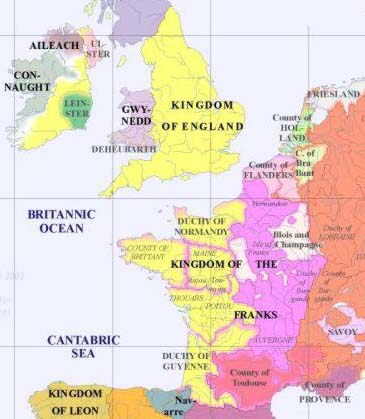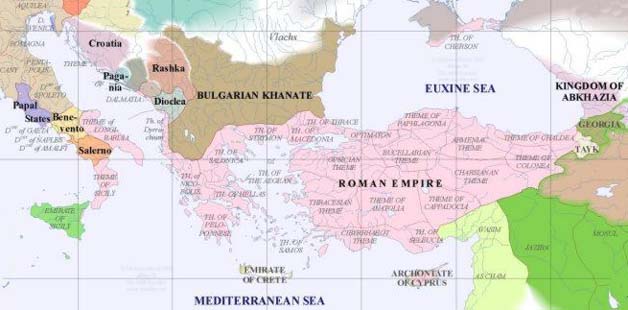Byzantium
 This page was set up by Robert Sewell in March 2006 to show our descent
from the Emperors of the Byzantine Empire. Robert Sewell graduated
from McMaster University (Hamilton, Ontario, Canada) in 1967 with a B.Sc.
degree in chemistry. After a year of studies at the University of
Toronto's College of Education, he taught high school science in Collingwood,
Ontario for a year and then taught chemistry, physics and general science
in Hamilton, Ontario for twenty-nine years. Robert Sewell retired
from teaching in June 1998.
This page was set up by Robert Sewell in March 2006 to show our descent
from the Emperors of the Byzantine Empire. Robert Sewell graduated
from McMaster University (Hamilton, Ontario, Canada) in 1967 with a B.Sc.
degree in chemistry. After a year of studies at the University of
Toronto's College of Education, he taught high school science in Collingwood,
Ontario for a year and then taught chemistry, physics and general science
in Hamilton, Ontario for twenty-nine years. Robert Sewell retired
from teaching in June 1998.
Please visit the Sewell
Genealogy Site Map
Click
to Contact Robert Sewell
Sources
Norman F. Cantor (ed.) The Encyclopædia of
the Middle Ages, New York, 1999
Fredrick L. Weis and Walter L. Sheppard: Ancestral
Roots, Baltimore, 1999
Barnes and Judson: History Atlas of Europe,
Macmillan Inc., New York, 1998
Barnes and Judson: History Atlas of Asia,
Macmillan Inc., New York, 1998
Berhard Grun, The Timetables of History,
New York, 1991
George Andrews Moriarty: The
Plantagenet Ancestry of King Edward III and Queen Philippa,
Mormon Pioneer Genealogical
Society, Salt Lake City, Utah, 1985.
David C. Douglas: William the Conqueror, University
of California, 1964.
The Book of History (18 Volumes), London,
1914
Periodical Historical Atlas
of Europe, http://www.euratlas.com
Melissa Snell, Mediaeval
History Guide, http://historymedren.about.com
Women in World History, http://www.womeninworldhistory.com
The Empire of Byzantium
Byzantium was the name of the ancient
Greek port at the Hellespont leading into the Black Sea. In 330 A.D., the
Roman Emperor Constantine the Great began transforming it into Constantinople;
and it became the capital of the eastern, Greek speaking part of the Roman
Empire. Constantine is thought to have chosen Byzantium as the new eastern
capital partly because he felt it was best to have a capital closer to
the crucial frontiers with Mespotamia and the Balkans, partly because it
was on a peninsula and hence relatively easy to defend, and partly because
he had converted to Christianity. Many of the old families of Rome continued
to worship classical pagan gods.
During the fifth century A.D., the
western or Latin speaking part of the Roman Empire was gradually overrun
by Germanic peoples; but Constantinople remained the capital of the Eastern
Roman Empire until it finally fell to the Muslims in 1453. The name "Byzantium"
stuck, and the eastern empire was known as the Byzantine Empire.
"And therefore I have sailed the seas and come
To the holy city of Byzantium."
William Butler Yeats: Sailing to Byzantium
|
As was the case with ancient Rome,
the Byzantine Empire was ruled by an authoritarian politcal system headed
up by an emperor. A dynasty gained control of the throne and ruled by hereditary
succession until it was overthrown. Of course, the emperor claimed to be
appointed by God.
By the year 900 A.D. the Byzantine
Empire consisted of most of modern Turkey and Greece as well as parts of
what is now the Crimea, Albania and Italy:
Generation One
Eudocia Ingerina
Born circa 840
Died 882/3
Eudocia was a mistress (a sort of secondary
wife) of Michael III, Emperor of Byzantium 842 - 867. She married Michael's
successor, Basil I, Emperor of Byzantium 867 - 886.
Michael III, son of the Emperor Theophilus,
was only thirteen years of age when he acceded to the throne in 842. A
regency was undertaken by his mother Theodora, his uncle Burdas who was
said to be a strong and unscrupulous character, and the Magister Manuel.
However, symptoms of madness appeared in the young emperor as he displayed
a passion for low company, extravagance, drunkeness and unrestrained lust.
Eventually, Michael's ex-groom and friend Basil gained control and became
a joint emperor. Basil then put Michael III to death and sole emperor as
Basil I.
Basil was descended from an Armenian
family of military colonists. His mother was called Pankalo and was said
to be of Slavic ancestry. Basil founded the "Macedonian Dynasty" which
lasted for two hundred years.
Eudocia, mistress of Michael III and
wife of Basil I, had a son. It is uncertain whether Michael or Basil was
the father of:
| References
Weis, Ancestral: 141A-15 The Book of History, Vol. VII, pg.
2942 - 2948 |
Generation Two
Leo VI "the Wise", Emperor of Byzantium
Born on September 1, 866
Died on May 12, 912
Emperor of Byzantium 886 - 912
Leo "the Wise" renewed and revived
the learning and laws from the past including the Code of Justinian - a
codification of Roman Law - dating from the time of Justinian the Great
who had ruled the Byzantine Empire over three hundred years earlier, from
527 to 565. Leo also displayed a keen interest in Theology.
Leo had the following children:
-
Anna of Byzantium. Anna's mother, Zoe Tzautzina, was
a mistress of Leo at the time of Anna's birth circa 886 - 888. Leo finally
married Zoe in 898.
-
Constantine VII who was born circa 906; he succeded Leo VI
in 912 as Emperor of Byzantium.
| References
Weis, Ancestral: 141A-16 The Book of History, Vol. VII, pg.
2948 - 2951 |
Generation Three
Anna of Byzantium
Born circa 886 - 888
Died circa 914
Anna married circa 900 to Louis "the
Blind" (circa 883 - 928), King of Provence and Italy. Louis "the Blind"
was a great grandson of Lothaire I, King of Italy and Emperor of the West
who was in turn a grandson of Charlemagne. Click HERE
for this descent.
Anna and Louis had a son:
-
Charles Constantine, Count of Vienne
| References
Weis, Ancestral: 141A-17, 141B, and 140-13, 14, 15. |
Generation Four
Charles Constantine, Count of Vienne
Born circa 900/1
Died circa January 962
Charles married Teutberg (died circa
960) and they had a daughter:
Generation Five
Constance of Provence
Died circa 961 - 965
Constance married circa 930 to Boso,
Count of Provence at Arles 949, and at Avignon 935, died 965/67, son of
Rotbaud I, a Burgundian, Seigneur d'Angel. Constance and Boso had
a son:
-
William I, Count of Provence
-
Rotbaud, Count of Provence
| References
Weis, Ancestral: 141A-19 Moriarty, pg. 27 |
Generation Six
William I, Count of Provence
Born in 950
Died circa 993-994
William married first to Arsenda de
Comminges and secondly to Adelaide (or Blanche), a daughter of Fulk II,
Count of Anjou. William and Adelaide had the following children:
-
William II Count of Provence who died in 1018
-
Constance of Provence
-
Ermengarde who married Robert, Count of Auvergne who
died in 1032.
| References
Weis, Ancestral: 141A-20 Moriarty, pg. 28 |
Rotbaud, Count of Provence
Died April 22, 1015
Rotbaud married Ermengarde and they
had a daughter:
Generation Seven
Constance of Provence
Born circa 986
Died on July 25, 1032
Constance married Robert (II) Capet
"the Pious", King of France. Please see Robert
(II) Capet "the Pious" for the continuation of this line.
| References
Weis, Ancestral, 141A-21, 141-21, 101-21 Moriarty, pg. 28 |
Emma of Provence
Emma married circa 990 William III
"Taillefer", Count of Toulouse (born circa 947; died in October 1037).
Emma and William had a son:
-
Pons III, Count of Toulouse
| References
Weis, Ancestral: 185-2 Moriarty, pg. 41, 42 |
| Note: Weis states in Line 185-2 that Emma
of Provence was a "gt. gr. dau. of Boso II, . . . and his wife, Constance
of Provence" and gives as his reference "Moriarty 42, 46". However, on
pages 27 and 28 Professor Moriarty shows Emma as a granddaughter of Boso
II as shown here. |
Generation Eight
Pons III, Count of Toulouse
Born circa 990
Died in 1060
Pons III married Almode, a daughter
of Bernard, Count of La Haute Marche and Périgord. Almode was murdered
by her stepson Raimond of Barcelona in 1071.
Pons and Almode had the following children:
-
William IV, Count of Toulouse
-
Almode who married Peter, Count of Melgueil
| References
Weis, Ancestral: 185-2 Moriarty, pg. 42 |
Generation Nine
William IV, Count of Toulouse and Duke of Norbonne
Born circa 1040
Died in 1093
William married Emma of Mortain, a
daughter of Robert, Count of Mortain and Earl of Cornwall. Robert of Mortain
was a son of Herleva and Herluin, Vicomte of Contreville. Prior to marrying
Herluin and while still in her teens, Herleva had been a girlfriend of
Robert I, 6th Duke of Normandy; their son was William the Conqueror. Thus,
Robert of Mortain was a half brother of William
the Conqueror. Robert and his brother Odo, Bishop of Bayeux and Earl
of Kent appear to have been very close to their half brother William. Both
Odo and Robert were most certainly present at the Battle
of Hastings.
William and Emma had a daughter:
-
Philippa (Matilda or Maud) or Toulouse
| References
Weis, Ancestral: 185-1, 185- 2 Moriarty, pg. 42
Douglas, Table 6 |
Generation Ten
Philippa (Matilda or Maud) of Toulouse
Born circa 1073
Died on November 28, 1117
Philippa married William VII "the Troubadour"
of Poitou (IX of Aquitaine). William was the first known troubadour, or
lyric poet, employing the Romance vernacular called Provencal.
William "the Troubadour" was a great X3 grandson
of Rolf the Ganger:
William (I) "Tête d' Etoupes", Count of Poitou
(born circa 915, died April 3, 963) who married Gerloc or Adela of Normandy
(born circa 917, died after January 14, 962), a daughter of Rolf
the Ganger, 1st Duke of Normandy. William and Adela had a son:
-
William (II) "Fier de Bras", Count of Poitou (born circa
937, died February 3, 995) who married Emma (born circa 950, died after
1004), a daughter of Theovald (I), Count of Alois. William and Emma had
a son:
-
William (III) "the Great", Count of Poitou and Duke of Aquitaine
(born circa 990, died a monk on January 31, 1030) who married Agnes (born
circa 995, died after November 9, 1068) a daughter of Otto William, Count
of Burgundy. William and Agnes had a son:
-
Gui Geoffrey, called William (VI), Count of Poitou (born
circa 1024, died on September 25, 1086) who married Hildegarde (died after
1104) a daughter of Robert (I) Duke of Burgundy, the first of the Burgundian
Capets, a son of Robert
(II) "the Pious" Capet, King of France. William and Hildegarde had
a son:
-
William VII "the Troubadour" of Poitou (IX of Aquitaine)
who married Philippa of Toulouse.
|
Philippa and William had the following
children:
-
William VIII "the Pious" of Poitou (X of Aquitaine)
-
Agnes of Poitou who married Ramiro II, King of Aragon.
-
Raymond of Poitou, born circa 1100
- 1104; killed by Saracens in 1149. Philippa of Toulouse may not have been
his mother; Moriarty shows him as being illegitimate. He became Prince
of Antioch by his marriage and is reputed to have had an "affair" with
his niece Eleanor of Aquitaine.
| References
Weis, Ancestral: 185-3, 110-24 Moriarty, pg. 36, 42 |
Generation Eleven
William VIII "the Pious" of Poitou (X of Aquitaine)
Born 1099
Died of food poisoning on April 9, 1137 in Galicia, Spain
while on a pilgrimmage to Santiago De Compostela.
William married in 1121 Eleanor de
Châtellárault, daughter of Almeric (Aimery) I, Viscount of
Châtellárault. Eleanor was a great granddaughter of Aimery
IV, Viscount of Thouars who was most certainly present at the Battle
of Hastings.
The descent of Eleanor from Aimery IV can be summarized
as follows:
Aimery IV, Viscount of Thouars, died in 1093, who was
present at the Battle
of Hastings, married Aurengarde de Mauleon and they had a daughter:
-
Eleanor de Thouars who married in 1075 Boso II, Viscount
de Châtellárault and they had a son:
-
Aimery I, Viscount de Châtellárault, who died
on November 7, 1151 as a monk at Notrre Dame de Noyers, married in 1109
to Dangerose, a daughter of Bartholomew de l'Isle Bouchard and his wife
Gerberga. Dangerose was later a mistress of William VII of Poitou (IX of
Aquitaine), father of William VIII "the Pious" of Poitou (X of Aquitaine).
Thus, Dangerose was her daughter's father in law's mistress. (This
certainly gets confusing!) Aimery I and Dangerose had a daughter:
-
Eleanor de Châtellárault who married William
VIII "the Pious" of Poitou (X of Aquitaine) as shown above.
| References
Weis, Ancestral: Line 183 Moriarty, pg. 45, 46 |
|
William VIII "the Pious" of Poitou
(X of Aquitaine) and his wife Eleanor de Châtellárault had
a daughter:
| References
Weis, Ancestral: 110-25 Moriarty, pg. 36 |
Generation Twelve
Eleanor of Aquitaine
Born circa 1123
Died on either March 31 or April 1, 1204
Eleanor was perhaps the most powerful
and influential persons of her time. As heiress to her father's vast estates
of Aquitaine and Poitou, she ruled a domain larger than that of the King
of France. Just after her father's death in April 1137, she married
(on July 25, 1137) the son of Louis VI "the Fat" Capet who promptly died
on August 1, 1137 leaving the teenaged Louis VII "the Young" Capet (age
17) and Eleanor of Aquitaine (age 15) as King and Queen of France.
Louis "the Young" and Eleanor went
together on the Second Crusade in the late 1140's. It was very unusual
for a lady to go on a crusade, but that didn't stop Eleanor. She is rumoured
to have engaged in assorted "affairs" with other men including her Uncle
Raymond while on the Crusade. The Second Crusade is remembered historically
as being a flop, but apparently Eleanor had a jolly time anyway.
Around this time, Eleanor and Louis
had two daughters:
-
Mary Capet, born in 1145
-
Alisa Capet, born in 1150
After the events of the Second Crusade,
Louis "the Young" was reputed to have become an old sourpuss. Undoubtedly,
Eleanor's conduct during the Crusade didn't help much in this regard. Louis
arranged to have the marriage annulled in early 1152. He got custody of
the children; but Eleanor kept her vast estates. Louis was apparently disappointed
with this settlement as he continued to use the title "Duke of Aquitaine"
for a year or so.

|
English Possessions
circa 1200 A.D.
Aquitaine is approximately that
portion of France shown on this map as "Thouars - Poitou".
Eleanor of Aquitaine was officially
a vassel of the King of France, but this didn't mean much. The part of
the "Kingdom of the Franks" controlled by England was larger than the part
controlled by the King of France. The combined possessions of Eleanor of
Aquitaine and her husband King Henry II Curtmantle (shown here in yellow)
were over twice the area controlled by the French.
Please visit
http://www.euratlas.com
for more great maps
|
Eleanor didn't waste any time in lining
up a new husband. On May 18, 1152, she married Henry Curtmantle who had
just turned 20 and was to become King Henry II of England two years later.
Eleanor was 30 and had a "bad reputation"; so Henry's father advised against
the marriage. Henry thought he was onto a good thing, so he married Eleanor
anyway. The relationship was a bit rough at times. This was due largely
to Henry's assorted affairs with other women; the details of which may
be perused by clicking HERE.
However, they had eight children including King Richard "the Lionhearted"
and King John.
For the continuation of this line, see The
Angevin Kings of England.
During the reign of her son Richard
"the Lionhearted", Eleanor played a significant role in holding England
together while Richard was crusading. When Richard was captured, Eleanor
helped raise the ransom to secure his release. Later, when John was king,
Eleanor helped defend his interests as well.
| References
Weis, Ancestral: 110-26, 101-24 & 25 Moriarty, pg.
36 |
Please visit the Sewell
Genealogy Site Map
Click
to Contact Robert Sewell
 This page was set up by Robert Sewell in March 2006 to show our descent
from the Emperors of the Byzantine Empire. Robert Sewell graduated
from McMaster University (Hamilton, Ontario, Canada) in 1967 with a B.Sc.
degree in chemistry. After a year of studies at the University of
Toronto's College of Education, he taught high school science in Collingwood,
Ontario for a year and then taught chemistry, physics and general science
in Hamilton, Ontario for twenty-nine years. Robert Sewell retired
from teaching in June 1998.
This page was set up by Robert Sewell in March 2006 to show our descent
from the Emperors of the Byzantine Empire. Robert Sewell graduated
from McMaster University (Hamilton, Ontario, Canada) in 1967 with a B.Sc.
degree in chemistry. After a year of studies at the University of
Toronto's College of Education, he taught high school science in Collingwood,
Ontario for a year and then taught chemistry, physics and general science
in Hamilton, Ontario for twenty-nine years. Robert Sewell retired
from teaching in June 1998.


